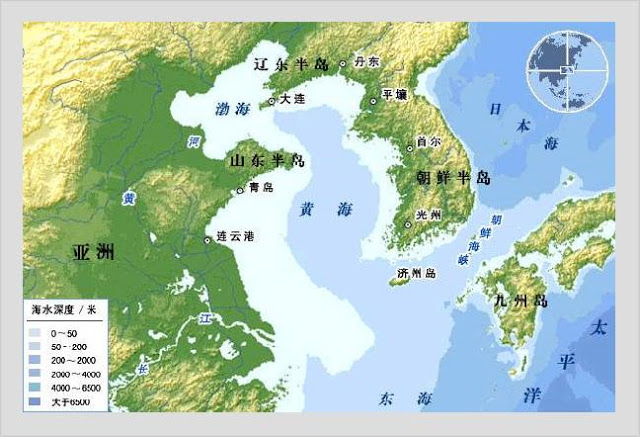
Renewed Violence in Kashmir Provides Window of Opportunity for Militants, Politicians
July 22, 2010
Second Artillery Anti-Ship Ballistic Missile Brigade Facilities Under Construction in Guangdong?
August 3, 2010By: Ian Easton and Tiffany Ma |
Naval tensions mounting over recent months in the Asia-Pacific have unfolded in a blue water drama featuring almost every seafaring nation in the region.
First, a South Korean patrol ship was attacked in the Yellow Sea on March 26, an event that triggered international concern and stoked diplomatic tensions. An international inquiry concluded that there was sufficient evidence that a North Korean torpedo sank the Cheonan, and U.S. Secretary of State Clinton confirmed that there was “overwhelming and condemning†evidence of North Korean responsibility. However, China prevailed in a U.N. resolution that “condemned†the sinking of a South Korean warship without mentioning North Korea by name – a move Pyongyang hailed as a diplomatic victory.
Soon after the Cheonan incident, Tokyo found itself facing aggressive Chinese naval maneuvers in its Exclusive Economic Zone. Repeated incursions by Chinese warships in April, May, and July as well as the recent live fire drills in the East China Sea that shut down a large zone off the coast of Zhejiang province to all vessel traffic has raised concern in Tokyo and around the region. While many speculated that these live fire exercises were a possible test bed for the Chinese anti-ship ballistic missile system (first acknowledged by U.S. officials in March to being in the testing phase), it appears that the more likely explanation for China’s recent maritime saber-rattling stems from its fierce opposition to the large scale U.S.-South Korean maritime exercise, code-named “Invincible Spirit.â€
 |
| A Chinese map of Northeast Asia |
As the U.S. Seventh Fleet turned out in force to participate in the first drill in a series of joint maritime and air readiness exercises in the Yellow Sea and Sea of Japan (called East and West Seas respectively by South Korea), the alliance also received a diplomatic boost from a historic “2+2†meeting. Secretary Clinton and U.S. Secretary of Defense Gates were both in South Korea to meet with their counterparts to discuss the content and scope of the exercises, which are aimed sending a strong signal to North Korea. Secretary Clinton also announced a new round of sanctions against North Korea for its alleged role in the Cheonan sinking.
For its part, Pyongyang has voiced its vehement displeasure to the exercises by threatening a “physical response†and stepping up its “nuclear deterrence†(potentially another nuclear test). Although the escalation in rhetoric has yet to be matched by action, such statements flame tensions at a time when the region is at the threshold of a “dangerous new periodâ€, as Gen. James Clapper put it. Pointing to an upward trend of violent provocations by Pyongyang, the nominee for the top U.S. intelligence post also cautioned that North Korea could attempt to advance its political goals through direct attacks. The likelihood of such scenarios is compounded by signs that North Korea is becoming more provocative as it braces itself for a difficult leadership transition. It is also unclear how Pyongyang will respond if Washington continues future military exchanges with Seoul under these circumstances, particularly as the Six Party Talks remain stalled and relations in the peninsula remain at a low point following the Cheonan incident.
Although Invincible Spirit was directed primarily at North Korea in response to the Cheonan sinking, China has also insisted that the presence of an aircraft carrier group in the Yellow Sea threatens its national security interests. A PLA official called the Yellow Sea a “sensitive area†and decried that the proximity of the carrier group will extend its attack radius over the entire mainland. Through a series of hyperbolic diplomatic protests, China appears to have successfully lobbied the U.S. to curb the planned exercises in the Yellow Sea. Some saw this as a testament to China’s “diplomatic wrestling,†although observers acknowledged that the change of location to the Sea of Japan was a tactical rather than a strategic adjustment.
In the long term, the relocation of the exercise may threaten freedom of navigation. Analysts caution that it sets a negative precedent by allowing China to establish and “expand its definition of core interests†in the area. Furthermore, Beijing may interpret this concession as a sign of Washington’s weakness and leverage it to undermine U.S. interests in maintaining freedom of navigation in the Yellow Sea, which is an international body of water. However, the Chairman of the Joint Chiefs of Staff Admiral Mike Mullen reassured that “the United States always reserves the right to operate in those, in international waters… we have exercised in the Yellow Sea for a long time, and I fully expect that we’ll do so in the future.”
 |
| The USS George Washington |
Nonetheless, this development is likely to complicate future U.S. carrier maneuvers in the region. Despite signs of goodwill such as the USS Nimitz making port call in Hong Kong earlier this year, China’s recent reaction stands in contrast to its lack of public opposition to the USS George Washington’s participation in a Yellow Sea exercise in October 2009.
China’s strong objections may turn out to be a strategic miscalculation in the long term as their responses to future U.S. – South Korean naval drills in the Yellow Sea will come under significant scrutiny from both domestic and international observers. Within China, the state-run media outlets have been blasting nationalistic sentiments and calling for revenge on the U.S. and South Korea in response to the exercises. This may set expectations that may be difficult to moderate in the future. Furthermore, if Beijing continues to step up its own maritime activities in the Yellow Sea, then it is likely to generate further frictions with its neighbors.
Beijing’s stance raises questions over its future reaction if the U.S. deploys a carrier to the region in the event of a security contingency to maintain stability or demonstrate solidarity with an ally. Similarly, it raises uncertainty as to whether China will be able to sufficiently raise the stakes to affect the U.S. strategic calculus with regard to its naval assets in the region. As the U.S. is unlikely to relinquish the option of deploying a carrier as a possible military response, managing any tensions that may arise will be a significant bilateral challenge in the absence of sound military-to-military relations.
In addition to managing relations with China, the U.S. will also need to address concerns in South Korea that the alliance may be overshadowed by the tug of war between U.S. and China in the Korean peninsula, particularly following the decision to relocate the exercises. However, there is also an acknowledgment that the U.S.-South Korea bilateral relationship has been on a positive trajectory, and China’s reaction is partially attributed to Beijing seeing the alliance in this new light. Going forward, balancing relations with China emerges as a key challenge for the alliance and the strength of the bilateral relationship will depend on how the two allies meet the challenge. That will require not only symbolic shows of alliance solidarity, but also substantive measures to enhance Seoul’s deterrence capabilities against North Korea before the transfer of wartime operational control of forces in 2015.
The recent spate of naval activity in the Asia-Pacific region also hints at the emerging competition that is evolving between the region’s great and rising powers and this emerging competition may lead to the destabilization of the region. The ongoing crisis on the Korean Peninsula and China’s ensuing reaction to the U.S.-South Korean exercise certainly serve as reminders of how events can cascade in an insecure environment.
 |
| Secretary Clinton at the ARF |
In particular, as the world’s eyes turn southward to the simmering tensions in the South China Sea, the increasingly complex dynamics in Asia may play out in yet another strategic maritime location. In addition to ongoing territorial disputes between surrounding nations, Secretary Clinton announced at the ASEAN Regional Forum last week that the area also is in the “national interest†of the United States, and that Washington would support a multilateral solution to territorial disputes surrounding it. That irked Beijing, which claims most of the South China Sea as its own, who insisted that all disputed claims be settled bilaterally, and opposes any efforts by outside actors to “internationalize†the issue. As regional stakeholders increasingly assert their national interest, balancing relations between major powers, peacefully resolving competing territorial claims and upholding the freedom of navigation in Asia all stand as significant maritime challenges.
The authors would like to thank Prashanth Parameswaran, former research assistant at the Project 2049 Institute, for assistance in this piece.Â




